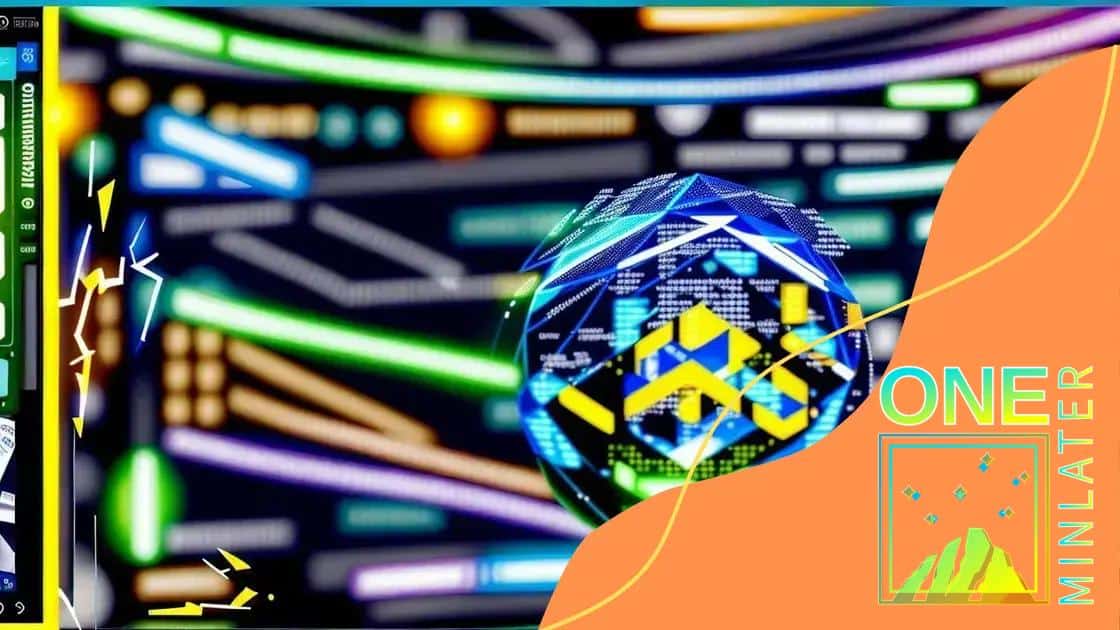Understanding decentralized finance (DeFi) applications

Understanding decentralized finance (DeFi) applications involves recognizing their benefits, such as financial autonomy and higher returns, alongside associated risks like smart contract vulnerabilities and market volatility.
Understanding decentralized finance (DeFi) applications can be a game changer for anyone looking into modern finance. Have you ever wondered how these platforms can reshape traditional banking?
What are decentralized finance applications?
Decentralized finance applications, often referred to as DeFi applications, are transforming the financial landscape. They leverage blockchain technology to offer financial services without traditional intermediaries, such as banks. This shift allows users to engage with their finances in a more direct and transparent manner.
Unlike conventional financial systems, DeFi applications enable users to lend, borrow, trade, and earn interest on their assets, all while maintaining control over their funds. These platforms operate on public blockchains, which enhances security and reduces the risk of censorship.
Key Features of DeFi Applications
The unique attributes of DeFi applications set them apart from traditional finance. These include:
- Accessibility: Anyone with an internet connection can access DeFi platforms.
- Transparency: All transactions are publicly recorded on the blockchain, ensuring accountability.
- Interoperability: DeFi apps can work seamlessly with one another, allowing users to move their assets freely.
- Smart Contracts: These automated contracts facilitate transactions without the need for intermediaries.
As you explore the world of decentralized finance, it is essential to understand the potential advantages and risks involved. For instance, DeFi applications can provide higher returns than traditional savings accounts, but they may also involve more volatility.
Innovations in the DeFi space continue to grow, presenting exciting opportunities for users to maximize their investments. As platforms evolve, so too does the array of services available, making it crucial to stay informed about new developments.
With the rapid expansion of decentralized finance applications, it’s essential to stay aware of the various options available. Whether you’re interested in earning passive income through lending your assets or exploring new investment strategies, the DeFi ecosystem is rich with potential.
Key features of DeFi applications
Understanding the key features of decentralized finance (DeFi) applications helps users navigate this innovative financial landscape. These features empower individuals to take control of their finances, making services more accessible than ever.
One standout aspect of DeFi applications is their accessibility. Anyone with an internet connection can use these platforms, allowing a global audience to engage. This inclusivity is revolutionary compared to traditional finance that often requires a bank account or proof of identity.
Decentralization
A major characteristic of DeFi applications is their decentralization. Unlike conventional banking systems, where authority is concentrated, DeFi systems operate on decentralized networks. This reduces the risk of fraud and increases trust among users.
- Transparency: All transactions are recorded on the blockchain, which means they are open for anyone to see.
- Immutability: Once a transaction is executed, it cannot be changed or deleted, ensuring accountability.
- Smart Contracts: These self-executing contracts help automate processes without the need for intermediaries, enhancing efficiency.
Moreover, DeFi applications offer various financial services, including lending, borrowing, trading, and earning interest on digital assets. This variety provides opportunities for users to grow their wealth in ways that traditional banking rarely offers.
Safety is another key feature of DeFi applications. With the integration of advanced cryptographic techniques, users can engage in transactions with peace of mind, knowing that their assets are secure. Additionally, the use of decentralized protocols minimizes the chances of a single point of failure.
As the DeFi ecosystem grows, innovations continue to emerge, enhancing user experience. This evolution reflects the dynamic nature of finance itself, where technology plays a pivotal role in shaping new possibilities.
Benefits of using DeFi platforms

The benefits of using DeFi platforms are numerous and provide significant advantages over traditional financial systems. These platforms enable users to engage with their finances in innovative ways that empower them more than ever before.
One major benefit is financial autonomy. Users maintain complete control over their assets, allowing them to set their terms for transactions. This independence eliminates the need for banks or brokers, fostering a sense of trust among users.
Higher Returns
DeFi platforms often offer higher returns compared to traditional investments. Users can earn interest on their deposits, which is typically higher than what conventional savings accounts provide. This opportunity for increased earnings makes DeFi more attractive for investors seeking alternative ways to grow their wealth.
- Lending and Borrowing: Users can lend their assets to earn interest or borrow by collateralizing their holdings.
- Yield Farming: Some platforms allow users to earn rewards through various liquidity provision strategies.
- Staking: Individuals can stake their tokens to earn additional tokens as rewards, enhancing their overall yield.
Another compelling advantage of DeFi platforms is the 24/7 availability. Unlike traditional banks that operate on fixed hours, DeFi services are always accessible. This means users can trade, lend, or borrow any time they choose, making it easier to manage their finances on their schedule.
Additionally, DeFi systems promote transparency. With all transactions recorded on the blockchain, users can verify every operation, enhancing trust in the platform. This level of accountability is a significant shift from traditional finance, where processes can often be opaque.
Moreover, DeFi platforms foster innovation within the financial sector. Each new application can potentially address unique needs and provide solutions that adapt more quickly to users’ preferences. This rapid evolution ensures users always have access to cutting-edge financial tools.
Challenges and risks in DeFi
While decentralized finance (DeFi) offers many benefits, it also comes with several challenges and risks that users should be aware of. Understanding these factors is crucial to making informed decisions in this innovative space.
A significant challenge in DeFi is the potential for smart contract vulnerabilities. Smart contracts are self-executing agreements coded on the blockchain. If these codes contain bugs or loopholes, they can be exploited by malicious actors. Users must ensure they are using trustworthy platforms with audited code to mitigate these risks.
Market Volatility
The cryptocurrency market, which powers many DeFi applications, is known for its extreme volatility. Prices of digital assets can fluctuate wildly in short periods. This volatility can lead to significant financial losses for investors who may not be prepared for such changes.
- Rapid Price Changes: Assets can gain or lose value in minutes.
- Liquidity Risks: Some assets may be hard to sell at desired prices during market downturns.
- Flash Loan Exploits: These can allow attackers to borrow large sums and manipulate the market in a short time.
Another risk to consider is the lack of regulatory oversight. Unlike traditional financial systems, DeFi operates in a largely unregulated environment. This can expose users to scams and fraudulent projects since there are fewer protections in place.
Users also face the possibility of losing access to their funds. If a user forgets their private key or loses access to their wallet, recovering those funds can be nearly impossible. Therefore, managing private keys and backups is crucial for safety.
Furthermore, the decentralized nature of DeFi means that there may be limited customer support. If users encounter issues, they may not have a central authority to turn to for help. This aspect can be daunting for those who are not tech-savvy and unfamiliar with blockchain technology.
The future of decentralized finance
The future of decentralized finance (DeFi) looks bright and full of potential. As technology continues to evolve, DeFi applications are expected to expand, bringing innovative solutions to the financial industry.
One significant trend shaping the future of DeFi is the growing adoption of layer 2 solutions. These solutions aim to improve scalability and reduce transaction costs on blockchain networks. By making transactions faster and cheaper, DeFi platforms can attract more users.
Integration with Traditional Finance
We also see an increasing integration between DeFi and traditional finance. Financial institutions are beginning to explore how they can collaborate with DeFi platforms. This collaboration could lead to more robust offerings for users and increase the legitimacy of DeFi in the mainstream financial system.
- Partnerships: Traditional banks could partner with DeFi platforms to offer enhanced services.
- New Financial Products: Innovative products combining DeFi principles and traditional finance may emerge.
- Regulatory Compliance: Collaborating with regulators can create a safer environment for DeFi services.
Furthermore, we can expect to see greater regulatory clarity. As DeFi continues to grow, regulators are paying closer attention. Their involvement may help protect users while maintaining the innovative spirit of DeFi. This balance could encourage new investments into the sector.
Moreover, DeFi applications are likely to become more user-friendly. Currently, many users find these platforms complex. Simplifying user interfaces and experiences can help attract a broader audience, including those who are not as tech-savvy.
Lastly, the ongoing shift towards sustainability will influence the future of DeFi. As the world becomes more aware of environmental issues, DeFi platforms may integrate more eco-friendly practices. Solutions that minimize energy consumption and promote sustainable investments will gain traction.
FAQ – Frequently Asked Questions about Decentralized Finance (DeFi)
What is decentralized finance (DeFi)?
Decentralized finance (DeFi) refers to financial services offered on blockchain networks that operate without intermediaries like banks, providing users with greater control over their assets.
What are the main benefits of using DeFi platforms?
The main benefits include financial autonomy, higher potential returns, accessibility 24/7, and increased transparency in transactions.
What risks should I be aware of with DeFi?
Users face risks such as smart contract vulnerabilities, market volatility, lack of regulatory oversight, and potential loss of access to funds.
How does DeFi interact with traditional finance?
DeFi is increasingly integrating with traditional finance, with partnerships forming and financial institutions exploring ways to collaborate for enhanced services.





